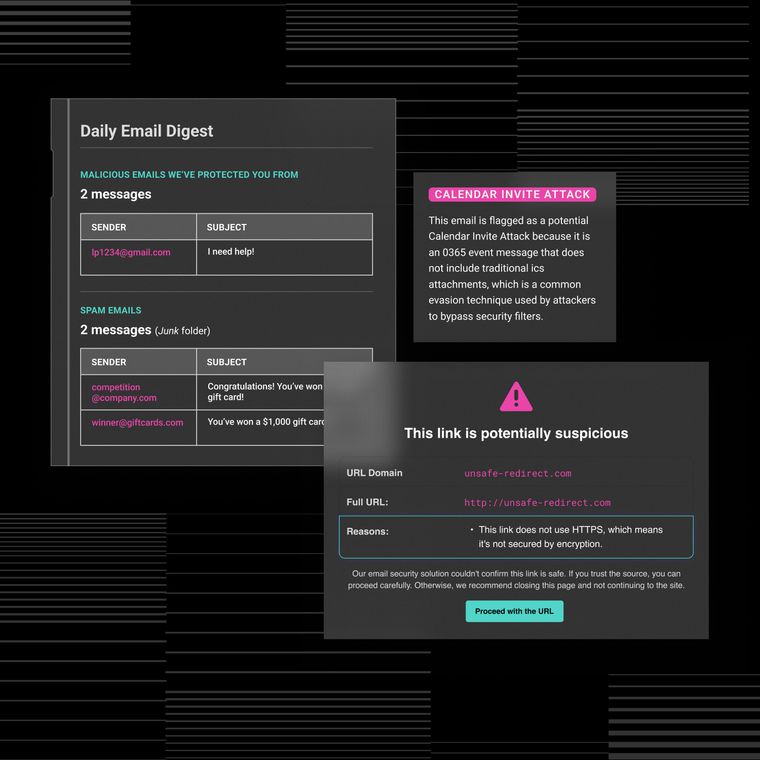Best Practices for Strengthening Email Security in the Cloud With AI
Discover best practices to enhance email security in the cloud and reduce exposure to modern email threats.
August 7, 2025
Native defenses block the majority of spam, but the sophisticated attacks that slip through are responsible for the most significant security losses. For instance, business email compromise causes organizations nearly $3 billion in annual losses, and traditional security mechanisms that rely on static signatures and predictable rules can be systematically evaded by attackers, underscoring the need for behavioral AI-based protections in platforms like Microsoft 365 and Google Workspace.
This creates dangerous security gaps where advanced threats exploit behavioral manipulation, abuse legitimate cloud services, and deploy social engineering techniques that evade conventional detection methods. Modern cloud email protection requires behavioral intelligence, seamless API integration, and automated response systems that go far beyond native capabilities.
Why Cloud Email Security Needs a New Approach
Native email security tools effectively block obvious spam but struggle with subtle, targeted threats that rely on social engineering rather than malware. These low-volume attacks often bypass static rules and reputation-based detection because they contain no known indicators.
Attackers take advantage of uniform security configurations by testing messages in controlled environments and reusing successful tactics across multiple organizations. Without visibility into user behavior, login patterns, or shifts in communication tone, native tools lack the context needed to spot these threats.
Modern defenses must go beyond signature matching to understand behavioral patterns and intent, closing the gaps traditional systems leave open.
Understanding What Gets Through Native Cloud Security
Despite built-in protections, platforms like Microsoft 365 and Google Workspace often miss sophisticated email threats. Attackers now evade detection not through malware, but by mimicking trusted behavior, leveraging familiar platforms, and avoiding traditional red flags. Understanding these gaps is essential to improving cloud email security.
The Threat Intelligence Gap
Attackers use newly registered domains, clean infrastructure, and phishing kits unseen by reputation engines. Since filters rely on historic indicators, novel attacks bypass detection, giving threat actors time to reuse successful techniques across organizations.
Zero-Day Links and Premium Services
Modern phishing often uses platforms like SharePoint or Google Drive to host second-stage payloads. These services are trusted by default, allowing attackers to embed malicious content behind legitimate URLs that evade standard scans.
Plain Text Attacks
Emails with no links or attachments, just convincing messages from impersonated executives or vendors, easily pass through filters. Without obvious technical markers, these low-volume, socially engineered messages go undetected without behavioral context.
Business Email Compromise
Once inside, attackers exploit legitimate accounts to redirect payments or steal sensitive data. Using real conversations and trusted contacts, they avoid detection while carrying out fraud that often isn’t discovered until long after the damage is done.
Today’s threats blend into everyday workflows and defeat signature-based defenses. Detecting these four attacks requires behavioral insight and contextual understanding. The following section explores seven best practices for strengthening email security in the cloud to close these visibility and response gaps.
1. Move Beyond Threat-Intelligence to Behavioral Analysis
Traditional security tools focus on known indicators like IP addresses and malware signatures. While effective against repeat threats, they often miss novel attacks that exploit human behavior and context.
Behavioral analysis offers a more adaptive approach. By monitoring identity, communication patterns, and content, it builds baselines for users and vendors, flagging subtle anomalies that suggest compromise. This includes unexpected logins, tone shifts in emails, or deviations in typical workflows.
Unlike static models, behavioral systems evolve with your environment, detecting zero-day phishing, account takeovers, and BEC attacks before damage occurs. This proactive strategy strengthens cloud email security by catching what traditional methods overlook.
2. Implement API-Based Security Integration
API-based security integrations add advanced protection in minutes by connecting directly to Microsoft 365 and Google Workspace without rerouting mail. A single authorization grants the platform cloud-native access to message metadata, user behavior, and historical mailboxes. That deep visibility powers behavioral analytics that catch sophisticated phishing, BEC, and account-takeover attempts your native filters miss.
The platform sits inside the tenant rather than in front of it, making deployment frictionless: a six-click install delivers zero downtime, and you never adjust MX records. With that same connection, you can surgically remove malicious emails after delivery, lock compromised accounts, or extend identical protections to Slack, Teams, and Zoom, actions legacy gateways cannot perform.
Compared with traditional gateways that proxy every message, an API-based security integration scales automatically, avoids latency, and evolves as the provider's APIs expand. You get stronger detection, faster remediation, and lower operational risk, all without changing how users send or receive email.
3. Automate Phishing-Report Processing
Automation turns user-reported emails from a languishing backlog into an immediate threat-intelligence asset, transforming reactive security operations into proactive threat elimination.
Here’s what you need to learn:
Kill the Black-Hole Mailbox With Automated Triage
Shared “abuse” mailboxes often become overloaded, with thousands of unreviewed reports and delayed responses to real threats. This outdated approach leaves malicious messages in users' inboxes for hours. Modern email security platforms automatically ingest reported messages, apply layered analysis, including header inspection, sandboxing, and behavioral scoring, and take immediate action via API.
Malicious emails are removed from all affected inboxes within seconds, while safe messages are automatically dismissed. Some platforms also provide instant feedback to users, closing the loop. This automation removes the manual triage burden and accelerates response, ensuring threats are neutralized before they can spread.
Measure ROI Through Faster, Consistent Response
Automated workflows reduce manual effort by handling enrichment, correlation, and remediation without analyst intervention. This shortens response times, increases consistency, and ensures every alert follows a standardized process. Dashboards highlight key metrics, like time to remediate and email removal rates, making it easier to track impact, optimize rules, and demonstrate security ROI while freeing analysts to focus on complex threats.
4. Create Intelligent User Feedback Loops
Turning users into active security participants starts with simple reporting and immediate, meaningful feedback. One-click reporting sends suspicious emails to automated analysis, which verifies links, headers, and payloads in seconds. Results return via API, with GenAI delivering clear, real-time explanations that reinforce intelligent behavior.
Gamified feedback, like streaks and recognition, keeps users engaged, while admin dashboards track performance by team or region. Low-code playbooks customize responses by role, enhancing relevance. Automating safe report resolution and escalating real threats cuts analyst workload, speeds response, and builds lasting security awareness across the organization.
5. Establish Comprehensive Threat Detection Coverage
Comprehensive threat detection pairs deep historical context with real-time, cross-channel visibility to catch sophisticated attacks that bypass traditional filters. Here’s what you need to do:
Build behavioral baselines through historical analysis. Deploy behavior-driven engines that require 45–60 days of historical data to learn your organization's normal communication patterns, file sharing habits, and financial workflows. Without this foundation, threat deviations become indistinguishable from routine activity.
Monitor across all communication platforms. Extend surveillance beyond email to include Slack, Teams, and Zoom, where attackers stage multi-step phishing campaigns by hopping between channels to avoid detection.
Correlate cross-platform intelligence. Combine login data, message content, and device details to create context depth that legacy Secure Email Gateways cannot match. Relationship graphs map normal payment flows, instantly flagging unexpected vendor bank-change requests where signature rules fail.
Leverage continuous analytics for real-time detection. Long-term baselines combined with always-on monitoring make every unusual permission change, login spike, or payment request stand out immediately, providing the time and evidence needed to respond before damage spreads.
6. Bridge IT & Security Team Collaboration
Strong cloud email security depends on collaboration between IT and security teams. Shared visibility, joint workflows, and clear accountability are key. Start with unified dashboards that display mailbox activity, user behavior, and threat intelligence for both teams. Integrate these signals into your SIEM or SOAR to trigger automated response playbooks, reducing manual workload and speeding up remediation.
Run joint tabletop exercises to simulate real scenarios like account takeovers or BEC. Ensure both teams understand escalation paths and response roles. Track shared metrics such as mean time to remediate, false-positive rates, and resolution of user-reported emails, and review them monthly to uncover gaps.
Breaking down silos leads to faster detection, reduced alert fatigue, and better protection for every message and mailbox.
7. Measure and Optimize Performance
Effective cloud email security requires continuous measurement and optimization through targeted KPIs that reveal system effectiveness and guide strategic improvements. Here are the steps to follow:
Track Detection Gap Ratios: Compare missed threats to successfully blocked attacks, providing clear insight into your system's ability to intercept sophisticated threats before they reach users. This metric directly measures defensive capability gaps.
Monitor Remediation Response Times. Measure mean time to remediate user-reported phishing attempts, as faster response times indicate more agile security operations capable of containing threats before they spread organizationally.
Assess Security Awareness Engagement: Track user interaction scores with in-line security coaching and training prompts to understand behavioral patterns, refine educational initiatives, and build a stronger security culture across teams.
Implement Quarterly Optimization Cycles: Establish regular reassessment periods aligned with adaptive risk models, ensuring threat management strategies evolve faster than adversary tactics and maintain defensive advantage.
These performance indicators provide actionable visibility into security framework effectiveness, enabling targeted improvements where they matter most. Security requires ongoing adaptation; committing to continuous measurement and optimization strengthens defenses and secures communication channels against evolving threats.
Implementation Strategy for Cloud Email Security
Deploy cloud email security through a structured, phased approach that strengthens defenses while maintaining operational continuity. Use the following steps given below for this:
Launch With Proof-Of-Concept Testing: Begin with a seven-day pilot using API integration to ingest historical mail data, establishing behavioral baselines while uncovering previously undetected threats.
Deploy in Graduated Enforcement Waves: Transition from monitoring to active enforcement by prioritizing high-risk groups like finance teams and executive assistants. This staged rollout prevents operational disruption while building organizational confidence.
Establish User Training Programs: Educate staff on updated reporting procedures, emphasizing how automated systems close benign tickets and recall malicious messages tenant-wide. Well-informed users become security force multipliers.
Maintain Continuous Performance Tracking: Monitor detection gaps, remediation times, and user engagement throughout deployment. Share weekly scorecards with leadership to sustain support and justify continued investment.
This methodical approach ensures measurable security improvements while maintaining stakeholder buy-in throughout implementation.
Common Pitfalls to Avoid
Cloud email defenses consistently fail due to four recurring mistakes that create exploitable vulnerabilities. Understanding and addressing these gaps transforms reactive security operations into proactive threat protection.
Over-Relying on Native Cloud Defenses: While Microsoft 365's built-in filters combine signature-based, heuristic, and behavioral analysis, sophisticated targeted attacks regularly bypass these protections. Attackers continuously refine phishing kits to evade traditional rules, making supplementary behavioral analysis essential for detecting anomalies that escape spam signatures.
Manual Threat Triage Bottlenecks: Abuse-mailbox queues accumulate thousands of user reports, overwhelming security teams and creating dangerous response delays. Automated playbooks that ingest, analyze, and retract to threats reduce analyst workload, transforming reactive operations into proactive threat hunting capabilities.
Treating Security Awareness as One-Time Training: Click rates inevitably rebound when education stops, leaving organizations vulnerable to previously defended attacks. Platforms delivering instant, personalized feedback with live analytics maintain consistently high awareness levels. Continuous micro-learning significantly outperforms annual training sessions.
Ignoring False Positive Impact: Excessive blocking erodes user trust and forces workarounds that bypass security controls entirely, creating the dangerous "cry-wolf" effect. Baseline-driven AI tools reduce unnecessary quarantines while preserving strict protection, maintaining both security effectiveness and user confidence.
Addressing these critical issues makes your security controls leaner, faster, and significantly more accurate at stopping real threats.
Strengthening Cloud Email Security with Abnormal's Approach
Abnormal delivers a modern, behavior-based approach that aligns with the seven best practices for cloud email security. Its platform uses Behavioral AI to analyze identity, behavior, and content, enabling accurate detection of advanced threats while minimizing false positives that burden security teams.
With API-based deployment, Abnormal integrates quickly and easily, enhancing protection without disrupting existing workflows. This seamless integration supports both operational continuity and security efficiency.
Recognized in the Gartner® Magic Quadrant™ for Email Security, Abnormal is built to address the evolving challenges of targeted attacks. To understand your risk posture and experience its impact firsthand, request a personalized demo.
Related Posts
Get the Latest Email Security Insights
Subscribe to our newsletter to receive updates on the latest attacks and new trends in the email threat landscape.


